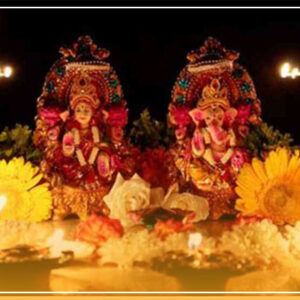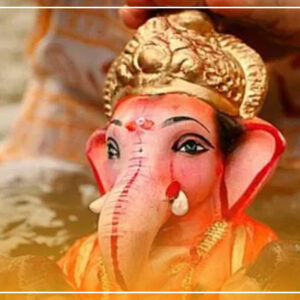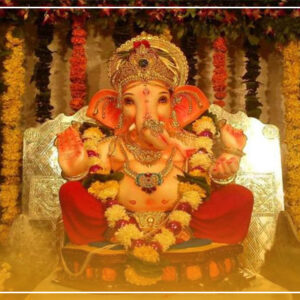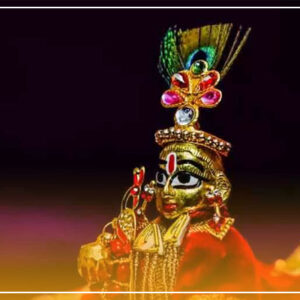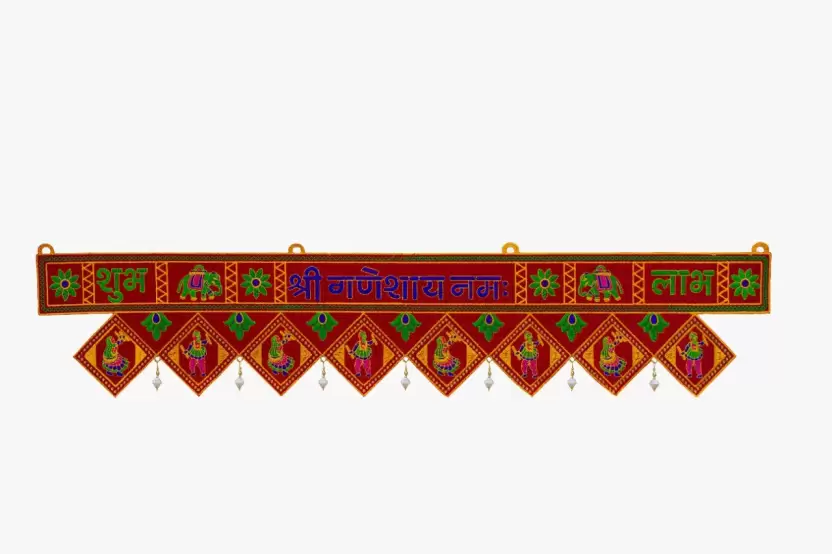Festive Pooja
-
Diwali Laxmi Pooja
Call for PriceAdd to WishlistAdd to Wishlist -
Ganesh Visarjan Pooja
Call for PriceAdd to WishlistAdd to Wishlist -
Ganpati Sthapana Pooja
Call for PriceAdd to WishlistAdd to Wishlist -
Janmashtami Pooja
Call for PriceAdd to WishlistAdd to Wishlist
Festive Pooja 4 Celebration & Shanti
Diwali Laxmi Pooja
Diwali is a major festival of the year which is celebrated all over world by Hindu people. People Worship Lord Ganesha, Goddess Laxmi and Lord Kuber on this auspicious day of Diwali.
Diwali is also known as ‘Deepavali’ – Deep – (lamps or diyas) and Avali (row) which means the row of clay diyas.
Why perform Lakshmi puja on Diwali
Diwali festival is meant to celebrate the victory of good over evil. It is the time when we refresh our minds and hearts and develop new hopes, confidence and energy that will create a new phase and tempo for the life ahead of us. Indian tradition believes that Goddess Mahalakshmi visits every household during Diwali carrying pots of luck, wealth and a host of other blessings. Performing Diwali puja on Diwali can help win the blessings of Goddess Mahalakshmi and invite prosperity, wealth, health and abundance into the household. The freshness of feeling and blessedness Lakshmi pooja can generate can be incomparable.
How to do Lakshmi pooja at home on Diwali
The best time to perform Lakshmi pooja on Diwali is the evening. The best Muhurat for the Lakshmi puja might fall between 6 pm and 8 pm and hence you can perform the puja anytime during this period.
For Diwali most households would have worn a new and clean look for facilitating the celebrations. If you have already cleaned the household, just set up the altar at the puja room and prepare for the puja.
1. या देवी सर्वभूतेषु लक्ष्मी रूपेण संस्थिता, नमस्त्यै नमस्त्यै नमस्त्यै नमस्त्यै नमों नम:।
अर्थ- हे मां आदि शक्ति आप सदैव हमारे पास लक्ष्मी (धन) के रूप में निवास करें। हम सभी आपको हृदय से आपको बारंबार नमस्कार करते हैं।
2. जय देवी जय देवी जय महालक्ष्मी।
वससी व्यापकरुपे तू स्थूलसूक्ष्मी।।
अर्थ- हे मां लक्ष्मी चारों दिशा में आपकी जय जयकार होती रहती है। आप ही जगत की पालनहार है और आप ही स्थूल रूप में इस जगत में समाई हुई है। हे मां लक्ष्मी आप हमें अपना आशीर्वाद प्रदान करें।
3. लक्ष्मी मां तुम्हारे चरण पूजत सब संसार।
रिद्धि-सिद्धि देकर हमें कर दो कृपा अपार।।
अर्थ- हे माता लक्ष्मी पूरा संसार आपकी पूजन करता रहता है। हम भी आपका भजन करते है और आपका आशीर्वाद प्राप्त करना चाहते हैं। हे माता कृपा करके हमें रिद्धि-सिद्धि प्राप्त करने का आशीर्वाद दें।
4. ॐ आद्यलक्ष्म्यै नम:,
ॐ विद्यालक्ष्म्यै नम:,
ॐ सौभाग्यलक्ष्म्यै नम:,
ॐ अमृतलक्ष्म्यै नम:,
ॐ कामलक्ष्म्यै नम:,
ॐ सत्यलक्ष्म्यै नम:,
ॐ भोगलक्ष्म्यै नम:,
ॐ योगलक्ष्म्यै नम:।।
अर्थ- हम सभी मां लक्ष्मी के सभी रूपों को बार-बार प्रणाम करते हैं। हे मां लक्ष्मी, विद्या लक्ष्मी, सौभाग्य प्रदान करने वाली मां लक्ष्मी, हे माता अमृत स्वरूपा, हे सत्य लक्ष्मी, वैभव लक्ष्मी, हे योगलक्ष्मी हम सभी आपको बार-बार प्रणाम करते हैं, आपको नमन करते हैं।
Ganesh Visarjan Pooja
Hindu households observe Ganesh Chaturthi to celebrate the incarnation of Lord Ganesh, the eldest son of Lord Shiva and Parvati. Ganesh is worshipped before one begins any auspicious work or job and pray to remove the obstacles and pave the way for growth, success, and prosperity.
What is Ganesh Visarjan?
For Ganesh Chaturthi puja, people get a new Ganesh idol made of perishable materials like clay, paper pulp, lime paste, or others. These idols are installed at the altar as a mark of inviting Ganesh to the household. Following the puja on Ganesh Chaturthi day, the idol is kept in the puja room/pandal for three or ten days, and finally the family bids farewell to the Lord. This is known as visarjan. As part of the Visarjan, the idol used for the puja is given a grand farewell and immersed in a water body.
The significance of Ganesh Visarjan
Every puja in Hindu tradition comprises three stages – Avahan (invitation or invocation), puja (worship), and Yathasthan (sendoff). During the invocation, the chief deity of the puja is placed on an elevated platform, and place a Kalash (sacred pot) filled with water, betel leaves, and coconut on top of it. The puja follows as per the tradition and is performed by the family. Yathasthan means giving a sendoff to the deity in a respectful manner after the prayers and thanking the Lord for his blessings. Ganesh Visarjan marks the farewell where the devotees give a sendoff to Lord Ganesh in a grand manner to commemorate the conclusion of the celebrations.
Ganesh Visarjan: Procedure for homes
Depending on the family tradition, Ganesh Visarjan is done on one and half-day or the third, fifth, seventh, ninth, or eleventh day. On the day of Ganesh Visarjan, the family gathers in front of the idol and performs the final puja with flowers, lighting diyas, incense sticks, modaks, ladoos and other eatables prepared for the day. The puja concludes with the waving of camphor flame in front of the idol.
The whole family chants prayers. The head of the family then sprinkles turmeric rice (Akshad) on the idol, finally doing a namaskar.
The eldest male member of the family touches the idol and gently moves it as a mark of starting the farewell journey.
One must offer curd and sweets to Lord Ganesha as they bid him farewell. The family bundles some rice and cereals in a red cloth to accompany him during his voyage back to his abode.
The family then chants the shlokas of Ganesh. The designated male member carries the idol and takes the idol around the house for a final round.
More members gather for the visarjan and set out to bid farewell to the Lord. Upon reaching the visarjan spot, which is usually a water body like river, lake, pond, or sea, the Ganesh idol is respectfully immersed in the water accompanied by the chanting of Ganesh names and slogans.
Ganpati Sthapana Pooja
Everyone around us is seen getting ready for the Ganesh Chaturthi celebrations filled with excitement, joy, love, and respect for our beloved Ganpati Bappa. Right from ordering the online Eco-Ganesha, preparing delicious sweets and food items, to cleaning the house and decorations, and so much more. Marking the birth of Lord Ganesha, this auspicious and wonderful Ganesh Chaturthi festival that brings happiness, good luck, prosperity, and joy to your life is coming up shortly!!
Moreover, Ganpati Bappa, who is also known as “The Remover of Obstacles”, i.e., Vighnaharta when worshipping at home, needs one to follow the right steps in the right way, thereby preserving its sanctity.
In order to install Lord Ganesha’s clay idol at home, devotees first clean their house and take a bath themselves. They then fill a Kalash with water, place a coconut on top of it and decorate it with betel leaves. The Ganesha idol is then placed on a platform which is at some height. The idol is then adorned with a sacred thread (Janve) on the left shoulder and adorned with a sandalwood paste tilak on the forehead and garlands; Durva grass and red flowers are offered to Ganesha. Mantras from Rigveda are recited to do pranpratishtha, a ghee lamp is lighted and the Lord is offered Modak while aartis are performed.
Devotees can bring Ganesha home for 1.5 days, 3 days, 7 days or 10 days.
Janmashtami Pooja
Devotees observe a daylong fast that is only broken with prasad after the puja. It is known as paran to break the fast. To celebrate Krishna’s birth, people also perform aarti, kirtan, and bhajan. To celebrate the festival, children sing Lord Krishna songs and people perform to Dahi-Handi.

